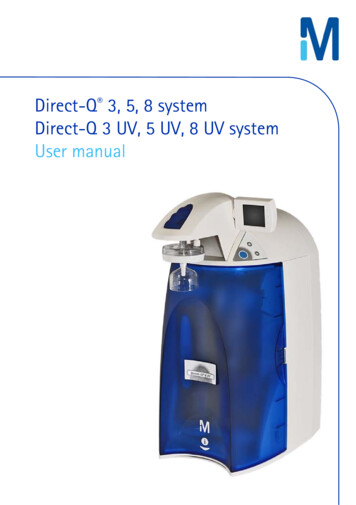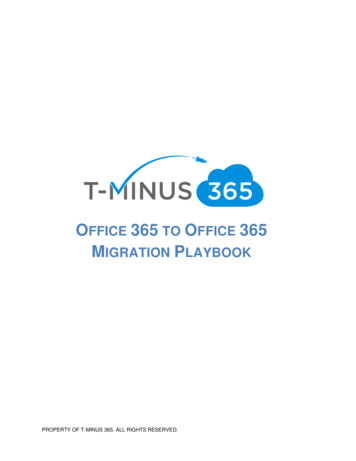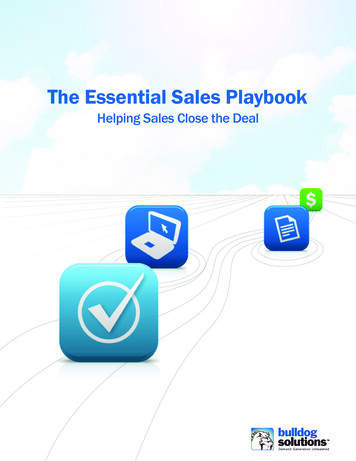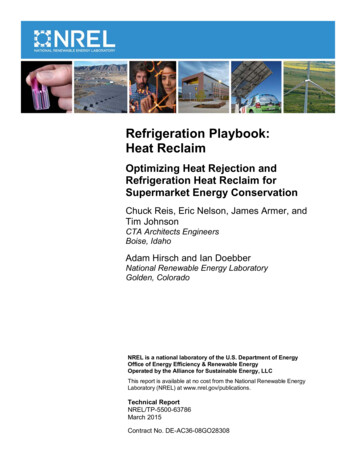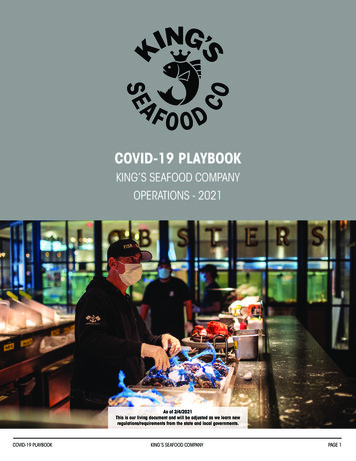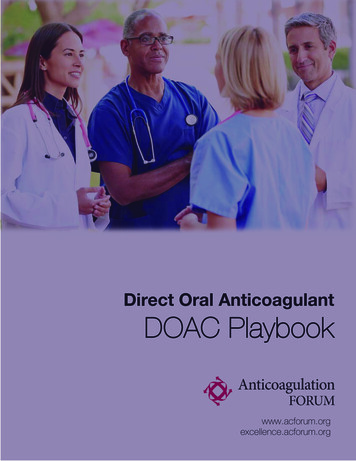
Transcription
Direct Oral AnticoagulantDOAC Playbookwww.acforum.orgexcellence.acforum.org
AcknowledgementsFundingANTICOAGULATION FORUMBOARD OF DIRECTORSThe Direct Oral Anticoagulant (DOAC)Playbook was produced by the AnticoagulationForum with funding provided by Janssen Inc.Scott Kaatz, DO, MSc, FACP, SFHM - PresidentHenry Ford HospitalContributorsJack Ansell, MD, MACPHofstra Northwell Zucker School of MedicineANTICOAGULATION FORUMSTEERING COMMITTEE MEMBERSGeoffrey D. Barnes, MD, MScUniversity of MichiganArthur Allen, PharmD, CACPPharmacist Clinician (Phc)Clinical Pharmacy SpecialistVA Salt Lake City Health Care SystemSalt Lake City, UtahDaniel Budnitz, MD, MPHCenters for Disease Control and PreventionGovernment Liaison to the Board of DirectorsJack Ansell, MD, MACPFormer Chairman, Department of MedicineLenox Hill HospitalNew York, New YorkNathan Clark, PharmD, FCCP, BCPSClinical Pharmacy SupervisorKaiser Permanente HospitalDenver, ColoradoLynn Oertel, RN, ANPClinical Nurse SpecialistMassachusetts General HospitalBoston, MassachusettsSara Vazquez, PharmD, BCPS, CACPUniversity of UtahHealth Thrombosis ServiceSalt Lake City, UtahDiane Wirth, ANP, CACPSenior Manager of Grady Heart Failure ProgramNurse PractitionerGrady Memorial Hospital, GeorgiaArthur Allen, PharmD, CACPVA Salt Lake City Health Care SystemMarilyn Blumenstein, MSN, CRNPChildren’s Hospital of PhiladelphiaAllison Burnett, PharmD, PhC, CACPUniversity of New Mexico Health Sciences CenterNathan Clark, PharmD, FCCP, BCPSKaiser Permanente ColoradoMark Crowther, MD, MSc, FRCPCMcMaster UniversityAdam Cuker, MD, MSUniversity of PennsylvaniaWilliam Dager, PharmD, BCPS, FASHP, FCCP,FCCM, MCCMUniversity of California Davis HealthSteven Deitelzweig, MD, MMM, FACC, SFHM,FACP, RVTOchsner Health SystemStacy Ellsworth, RN, MSM, CCRCHenry Ford HospitalDavid Garcia, MDUniversity of WashingtonEva Kline-Rogers, MS, NP, AACCUniversity of MichiganTracey Minichiello, MDUniversity of California, San FranciscoSara Vazquez, PharmD, BCPS, CACPUniversity of Utah HealthDiane Wirth, ANP, CACPGrady Memorial HospitalJuly 2021 v15.1
Table of ContentsIntroduction 3Impetus for Change 3National Patient Safety Goals 5About this Playbook 6Management of DOACs 7Overview 7General DOAC Information 8Patient Selection 13Switching to DOACs 15Periprocedural Guidance 16Laboratory Monitoring 21Managing Drug-Drug Interactions 23Managing DOAC-associated Bleeding 26Managing Transitions of Care 30Patient and Family Education 30Resources 32Appendix 35Summary Guidance Statements from the Anticoagulation Forum for the Practical Management ofthe DOACs in VTE Treatment 35Special Populations 38Abbreviations 44Prescribing Information 48References 491
IntroductionIMPETUS FOR CHANGEWhy do we need better management of DOACs?Direct oral anticoagulants (DOACs), a class of oral anticoagulants first introduced to the US market in2010, have replaced warfarin as the preferred anticoagulant for stroke prevention in nonvalvular atrialfibrillation (NVAF), adjunct treatment and prevention of major cardiovascular events in patients withchronic coronary/peripheral artery (CAD/PAD), and for the treatment and prevention of venousthromboembolism (VTE), including in the medically ill patient or following hip or knee replacementsurgery. DOACs directly neutralize a specific clotting factor (factor Xa or IIa), whereas warfarininterferes with the synthesis of active vitamin K-dependent clotting factors (II, VII, IX and X).1 TheDOACs are as effective as warfarin and appear to be safer, especially with reference to intracranialhemorrhage.2 DOACs have a wide therapeutic index that does not require routine monitoring ofanticoagulation effect for the purpose of dose titration. In addition, they have few important drug-druginteractions and almost no dietary interactions. This is in comparison to warfarin therapy, which islinked to numerous nutrient, disease, and drug interactions; safe use of warfarin therefore necessitatesclose patient monitoring3 and regular patient/caregiver interactions. DOACs now represent over 80% ofnew prescriptions for oral anticoagulant therapy.4Although DOACs require less intensive dose management than warfarin, they are not devoid ofpotential complications. Anticoagulants have consistently ranked as the class of medications mostfrequently leading to emergency room visits and hospital admissions for adverse drug events(ADEs).4–6 Between 2013 and 2014, the DOACs rivaroxaban and dabigatran were the fifth and tenthmost common drugs, respectively, to cause emergency room visits for ADEs in older adults.6Hospitalization rates for DOAC-related ADEs were similar to that of warfarin, and the number of ADEreports for anticoagulants as a class (DOACs and warfarin) increased more than fourfold from 1576(7.3%) in 2005-2006 to 7211 (17.6%) in 2013-2014.4Improving the systematic management of anticoagulants within and across care settings is a keypriority for regulatory and government agencies, via such means as the US Department of Health andHuman Services National Action Plan for Adverse Drug Event Prevention, the Joint Commission’supdate of the National Patient Safety Goals to include DOAC management, and the recentdevelopment of an Anticoagulation Stewardship initiative sponsored by the Food and DrugAdministration.7Is there evidence that DOACs require better management?In the warfarin era, a systematic approach to anticoagulant management using dedicated systems,such as anticoagulation clinics, improved outcomes by reducing thrombosis and major bleeding andmay have also generated financial benefits.8,9DOACs require providers to evaluate and manage the practical aspects of therapy, including theappropriate indication, dosage, monitoring of selected parameters, drug-drug interactions, transitioningto alternate anticoagulants, and reversal of activity in the event of bleeding or need for surgery.10Guidelines endorse a systematic approach to DOAC management to ensure consistent assessment oflabs, drug interactions, bleeding risk factors, etc.113
IntroductionReal-world evidence indicates suboptimal DOAC use, particularly off-label dosing.12 In the ORBIT-IIregistry of over 11,000 patients with atrial fibrillation (AF), 1 in 8 patients in the community receivedinappropriate dosing. Overdosing was associated with an increased all-cause mortality compared withrecommended doses (hazard ratio [HR], 1.91; P .04). Underdosing was associated with increasedcardiovascular hospitalization (HR, 1.26; P .007).13 Similar findings were found in patients treated forpulmonary embolism,14 where 4.3% of a large cohort were inappropriately dosed (all underdosed)resulting in an adverse event rate of 25% vs a rate of 6.1% in those who were dosed appropriately (riskratio [RR], 3.19; P .001). In a mixed population of patients admitted to the hospital on a DOAC,investigators found that inappropriate dosing occurred in 25% of patients.15 Improved dosing, however,was seen in a Veterans Administration cohort of over 5000 NVAF patients managed by pharmacist-ledanticoagulation services, where only about 7% of patients were inappropriately dosed, although thisrate was higher in those with chronic kidney disease (17%).16Impaired renal function is a particular problem with DOACs, since all of these agents rely to a greater orlesser extent on renal elimination of unchanged drug. A recent report examined a cohort of 1473patients with impaired renal function who were treated with a DOAC and found that 43% wereoverdosed. This was associated with a higher risk of major bleeding (HR, 2.19; 95% CI, 1.07-4.46). Inthe same study, of 13,392 patients without renal impairment, 13% were underdosed, which wasassociated with a higher risk of stroke (HR, 4.87; 95% CI, 1.30-18.26).17Improving DOAC therapy can be achieved by a variety of interventions. On an institutional basis,implementing an anticoagulant stewardship program can lead to improved anticoagulant therapyoutcomes,7 especially through the creation of an anticoagulant management service.18 Such servicesenhance not only warfarin therapy but DOAC therapy as well, as shown by one study whereinvestigators achieved a 58% reduction in inappropriate dosing after implementation of such a servicein a community teaching hospital.19Lastly, improved management of DOACs, especially focused on adherence to therapy, can result inhealth care cost reduction, as shown in a study of 2981 patients.20 Adjusted all-cause total cost for a12-month period was significantly lower ( 29,742 vs 33,609) among adherent vs nonadherent users.Accumulating real-world experience suggests patients who are prescribed DOACs require skilledmanagement by specialized health care practitioners to reduce ADEs and to achieve optimal outcomes.Leveraging the efficient, coordinated care provided within an anticoagulation management service isthe ideal resource to realize optimal anticoagulant therapy outcomes while potentially reducing healthcare costs.4
IntroductionNATIONAL PATIENT SAFETY GOALSThe Joint Commission (TJC), the nation’s oldest and largest standards-setting and accrediting body inhealth care, established the National Patient Safety Goals (NPSG) program in 2002 to help accreditedorganizations address specific patient safety concerns.21 The NPSGs are actions that accreditedorganizations are required to take in order to prevent medical errors. The safety goal regardinganticoagulation therapy (NPSG.03.05.01) is:“Reduce the likelihood of patient harm associated with the use ofanticoagulant therapy.”The NPSG Elements of Performance (EPs) to reduce harm associated with anticoagulant therapy aresummarized below.22EP 1: The [hospital/organization] uses approved protocols and evidence-based practiceguidelines for the initiation and maintenance of anticoagulant therapy that addressmedication selection; dosing, including adjustments for age and renal or liver function;drug-drug and drug-food interactions; and other risk factors as applicable.EP 2: The [hospital/organization] uses approved protocols and evidence-based practiceguidelines for reversal of anticoagulation and management of bleeding events related to eachanticoagulant medication.EP 3: The hospital uses approved protocols and evidence-based practice guidelines forperioperative management of all patients on oral anticoagulants.EP 4: The [hospital/organization] has a written policy addressing the need for baseline andongoing laboratory tests to monitor and adjust anticoagulant therapy.EP 5: The [hospital/organization] addresses anticoagulation safety practices through thefollowing: Establishing a process to identify, respond to, and report adverse drug events, includingadverse drug event outcomes Evaluating anticoagulation safety practices, taking actions to improve safety practices,and measuring the effectiveness of those actions in a time frame determined by theorganizationEP 6: The [hospital/organization] provides education to patients and families specific to theanticoagulant medication prescribed, including the following: Adherence to medication dose and schedule Importance of follow-up appointments and laboratory testing (if applicable) Potential drug-drug and drug-food interactions The potential for adverse drug reactionsEP 7: The [hospital/organization] uses only oral unit-dose products, prefilled syringes, orpremixed infusion bags when these types of products are available.EP 8: When heparin is administered intravenously and continuously, the[hospital/organization] uses programmable pumps to provide consistent and accurate dosing.5
IntroductionBy following TJC standards, medication errors can be prevented, patient safety increased, and overallbetter health care outcomes achieved.23ABOUT THIS PLAYBOOKAs leaders in the field of anticoagulant therapy, the Anticoagulation Forum (AC Forum) has written thefollowing guidance on managing patient care with DOACs. This playbook incorporates both evidencebased data and consensus opinion to provide practical guidance on a range of real-world clinicalsituations that may be encountered by anticoagulation services, emergency room physicians, internists,cardiologists, hematologists, and others. The AC Forum initiated this comprehensive guidance projectto provide easily accessible information about the therapies that can be readily put into practice.This Playbook is not an informed practice guideline; it is Anticoagulation Forum, Inc.’s bestrecommendation based on current knowledge, and no warranty or guaranty is expressed or implied.The content provided is for informational purposes for medical professionals only and is not intended tobe used or relied upon by them as specific medical advice, diagnosis, or treatment, the determination ofwhich remains the responsibility of the medical professionals for their patients. The Playbook may bereproduced in part or in its entirety if credited to the Anticoagulation Forum.Further information and handouts are available at the AC Forum website at www.acforum.org.Revised 7-13-2021 2021 Anticoagulation Forum6
Management of DOACsOVERVIEWThe introduction of DOACs as an alternative to low-molecular-weight heparins (LMWH) and warfarinrequires health care organizations to modify existing protocols and use evidence-based practiceguidelines to address the initiation and maintenance of all anticoagulation medications and theirassociated risks.Using DOACs safely and effectively requires that all aspects of anticoagulation therapy areaddressed,11 including appropriate patient selection, dosing, monitoring, transitions between therapiesand between care settings, periprocedural guidance, management of risks (including DOAC-associatedbleeding), drug-drug interaction management, ongoing assessment of patient and family educationalneeds, and incorporation of evidence-based practices into workflow.For the practicing physician or health care provider not based in an institutional setting, every effortshould be made to follow these guidelines when prescribing a DOAC.7
Management of DOACsGENERAL DOAC INFORMATIONApixaban (Eliquis )24Dabigatran (Pradaxa )25Edoxaban (Savaysa )26Rivaroxaban (Xarelto )27TargetFactor XaThrombinFactor XaFactor me to peak effect1-2 hours1-3 hours1-2 hours2-4 hoursHalf-life12 hours8-15 hours10-14 hours7-11 hoursRenal clearance25%80%50%33%Must be stored in its originalcontainer to protect frommoistureNotesMust be given with food atdoses 10 mgIndicationsNVAF Treatment of acute DVTand/or PE Reduction of risk ofrecurrent DVT and/or PE Prophylaxis of DVT and/orPE following hip or kneereplacement surgery After 5-10 days ofparenteral anticoagulation After 5-10 days ofparenteral anticoagulation * *Hip onlyProphylaxis of VTE inacutely ill medical patientsat risk for thromboemboliccomplications, not at highrisk of bleedingReduction of risk of MACE(CV death, MI, and stroke)in chronic CAD/PADContraindications/Not Recommended( avoid as per PI; avoid as per clinical recommendation); refer to “Patient Selection” on pg. 13 for further details)8
Management of DOACsApixaban (Eliquis )24Dabigatran (Pradaxa )25Edoxaban (Savaysa )26Active pathological bleeding Severe hypersensitivity torespective medicationMechanical prosthetic heartvalves Pregnancy (category per PI) Breastfeeding (evidence ofsecretion into milk) Triple positive APSDrug interactionsRivaroxaban (Xarelto )27Refer to Drug Interactions belowDOAC Dose AdjustmentsHepatic impairmentRenal impairmentChild-Pugh B: Avoid oruse with cautionChild-Pugh C: Avoid useNo adjustmentChild-Pugh B: Avoid oruse with cautionChild-Pugh C: Avoid useChild-Pugh B: Avoid oruse with cautionChild-Pugh C: Avoid useRefer to Dosing Per Indication below for specific dosing recommendationsBody WeightOverweightLow WeightUse with caution in BMI 40 kg/m2If NVAF plus 2 additionalrisk factors, doseadjustment (see dosingspecifics below)No adjustmentIf VTE and 60 kg, doseadjustment (see dosingspecifics below)No adjustmentDrug Interactions9
Management of DOACsApixaban (Eliquis )24PharmacoDYNAMICdrug interactionsPharmacoKINETICdrug interactions*drug lists are not exhaustiveDabigatran (Pradaxa )25Edoxaban (Savaysa )26Rivaroxaban (Xarelto )27Avoid or minimize concomitant use of antiplatelets and/or NSAIDs whenever possibleEliminated/metabolized by: P-gp efflux transportersystem CYP3A4 hepaticisoenzyme systemEliminated by: P-gp efflux transportersystemEliminated by: P-gp efflux transportersystemEliminated/metabolized by: P-gp efflux transportersystem CYP3A4 hepaticisoenzyme systemP-gp and/or strongCYP3A4 INDUCERS(e.g., barbiturates,carbamazepine, phenytoin,rifampin, St. John’s Wort)*Avoid use of DOACs OR transition to alternative medication without P-gp/CYP inducing effects, when appropriateP-gp INHIBITORS(e.g., amiodarone, carvedilol,diltiazem, dronaderone,azithro/clarithro/erythromycin,oral itra/ketoconazole, quinidine,verapamil)*Dual P-gp and strongCYP3A4 INHIBITORS(e.g., clarithromycin , oral itra/ketoconazole, cobicistat,indinavir, ritonavir, saquinavir,teleprevir)*Dual P-gp and moderateCYP3A4 INHIBITORS(e.g., cyclosporine, diltiazem,dronaderone, erythromycin,verapamil)*N/A Decrease induction/maintenance dose by 50%if on 5 mg twice daily or 10mg twice daily Avoid use if already on 2.5mg twice daily No dose adjustmentneeded with concomitantuse of clarithromycinUse with cautionDosage Forms and Administration10Estimated CrCl 50 mL/min:Avoid use orreduce dose30 mg once dailyN/AAvoid useN/AN/AN/A No dose adjustmentN/AEstimated CrCl 80 mL/min Avoid use unless benefitjustifies potential riskneeded with concomitantuse of clarithromycin
Management of DOACsApixaban (Eliquis )24AdministrationTwice daily with or withoutfoodDosage forms and strengthsTablets:2.5 mg and 5 mgDabigatran (Pradaxa )25Edoxaban (Savaysa )26Rivaroxaban (Xarelto )27 Twice daily with or withoutfood Must be kept in originalpackaging Do not crush or opencapsuleCapsules:75 mg, 110 mg, 150 mgOnce daily with or withoutfood150 mg twice daily60 mg once daily20 mg once daily with food Avoid if CrCl 15 mL/minor on dialysis Reduce dose to 75 mgtwice daily if CrCl 15-30mL/min Reduce dose to 75 mgtwice daily if CrCl 30-50mL/min and concomitantuse of P-gp inhibitorsdronedarone or systemicketoconazole (outcomedata not available) Avoid co-administrationwith P-gp inhibitors* if CrCl 30 mL/min150 mg twice daily AFTER5-10 days of parenterallead-in Avoid if CrCl 95 mL/min Reduce dose to 30 mgonce daily if CrCl 15-50mL/min Reduce dose to 15 mg60 mg once daily AFTER5-10 days of parenterallead-in15 mg twice daily for 21days, then 20 mg once dailyTablets:15 mg, 30 mg, 60 mg Doses 10 mg daily: onceor twice daily with orwithout food Doses 10 mg daily: onceor twice daily with largestmeal of dayTablets:2.5 mg, 10 mg, 15 mg,20 mgDosing Per IndicationNVAFTreatment ofacute DVT and/or PE5 mg twice dailyRecommended dose is 2.5mg twice daily if at least 2 ofthe following characteristicsare present: age 80 years, body weight 60 kg, OR serum creatinine 1.5 mg/dL10 mg twice daily for 7 days,then 5 mg twice daily Avoid if CrCl 30 mL/minor on dialysis Avoid co-administrationwith P-gp inhibitors* if CrCl 50 mL/min Reduce dose to 30 mgonce daily if CrCl 15-50mL/min or body weight 60 kg or using certain Pgp inhibitors*once daily with food ifCrCl 50 mL/min Take with food Avoid if CrCl 30 mL/min11
Management of DOACsApixaban (Eliquis )24Reduction of risk ofrecurrent DVT and/or PEProphylaxis of DVT and/orPE following hip or kneereplacement surgery2.5 mg twice daily after 6months of initial treatment150 mg twice daily afterinitial treatmentNot FDA approved for thisindication Avoid if CrCl 30 mL/minor on dialysis Avoid co-administrationwith P-gp inhibitors* if CrCl 50 mL/minFor hip replacement only:110 mg day 1, then 220 mgonce daily for 28-35 days Avoid if CrCl 30 mL/minor on dialysis Avoid co-administrationwith P-gp inhibitors if CrCl 50 mL/minNot FDA approved forknee replacementNot FDA approved for thisindicationNot FDA approved for thisindicationNot FDA approved for thisindication2.5 mg twice daily for12 days (knee) or 35 days(hip)Give first dose 12-24 hoursafter surgeryProphylaxis of VTE inacutely ill medical patientsat risk for thromboemboliccomplications not at highrisk of bleedingReduction of risk of MACE(CV death, MI, and stroke)in chronic CAD/PADDabigatran (Pradaxa )25Edoxaban (Savaysa )26Not FDA approved for thisindicationRivaroxaban (Xarelto )2710 mg once daily after 6months of standardtreatment Avoid if CrCl 30 mL/minNot FDA approved for thisindication10 mg once daily for 12days (knee) or 35 days (hip) Avoid if CrCl 30 mL/minNot FDA approved for thisindication10 mg once daily in hospitaland after hospital dischargefor a total recommendedduration of 31-39 daysNot FDA approved for thisindication2.5 mg twice daily incombination with aspirin(75-100 mg) once dailyAbbreviations: APS, antiphospholipid antibody syndrome; BMI, body mass index; CAD, coronary artery disease; CrCl, creatinine clearance; CV, cardiovascular; CYP3A4,cytochrome 3A4; DOAC, direct oral anticoagulant; DVT, deep vein thrombosis; FDA, Food and Drug Administration; MACE, major cardiovascular events; MI, myocardialinfarction; NSAID, nonsteroidal anti-inflammatory drug; NVAF, nonvalvular atrial fibrillation; PAD, peripheral artery disease; PE, pulmonary embolism; P-gp, Pglycoprotein; PI, prescribing information; VTE, venous thromboembolism.12
Management of DOACsPATIENT SELECTIONClinical guidelines now favor DOACs over other therapies for the treatment and prevention ofthromboembolic complications in the setting of NVAF and VTE. DOACs are also indicated for VTEprophylaxis following knee/hip surgery and in medically ill patients and have also been used asadjunctive treatment to prevent cardiovascular events in patients with CAD/PAD. However, DOACs arenot appropriate for all candidates, and patient selection is crucial when considering the safe andeffective use of DOACs in these populations. Risk factors for bleeding and potential stratification ofthose risks should be considered.When deciding on anticoagulant therapy, one must make sure the benefit (preventing thrombosis)outweighs the risk (major bleeding). Although the risk rarely exceeds the benefit, especially in the longterm, some risk factors to consider are listed below. These may be helpful in determining patient followup during therapy.Patient-Specific Risk Factors for Bleeding11 Active or metastatic cancerAge (e.g., 65 years and older)Alcohol abuseAnemia and other blood dyscrasiasComorbidity and reduced functional capacityConcomitant medications such as nonsteroidal anti-inflammatory drugs (NSAIDs), antiplatelets,or other anticoagulants administered, possibly in a transition periodDiabetesFrequent fallsHepatic or renal dysfunctionHistory of bleeding, especially gastrointestinal (GI) bleedingHistory of gastroduodenal ulcerRheumatic diseasePrevious strokeRecent surgeryThrombocytopeniaAlthough there are well-known bleeding risk scores, such as the HAS-BLED, ATRIA,HEMORR2HAGES, and ORBIT scores, these were developed in patients receiving warfarin and havenot been rigorously validated in patients treated with DOACs.2813
Management of DOACsPatients who should avoid the use of DOACs, or for whom there are specific considerations, are listedbelow. Additional details and references on all special populations are listed in the appendix (see page38).Patients Who Should Avoid DOACs Indications for which DOACs have been proven inefficacious and/or harmful: Mechanical heart valve replacement29 Left Ventricular Assist Device (LVAD)30 Triple Positive Antiphospholipid Antibody Syndrome (APS) 8, 12, 31, 32,33 Embolic Stroke of Undetermined Source (ESUS) 34, 35 Transcatheter Aortic Valve Replacement (TAVR) 36 Within 3 months of a bioprosthetic heart valve replacement 37 Valvular AF38–40 Severe hepatic impairment37 Pregnant or breastfeeding27 Women of child-bearing potential NOT using a reliable method of contraception27 Taking medications known to SIGNIFICANTLY interact with DOAC27, 41 Unable to consistently pay for DOAC through personal funds, insurance, or assistance programsControversies (Discuss Risk/Benefit Prior to Use) Off-label indications VTE associated with GI or genitourinary (GU) cancer42,43 Moderate hepatic impairment37 Severe renal impairment (CrCl 30 mL/min) 44,45 Taking moderate inhibitors of DOAC metabolism in the setting of moderately impaired renalfunction 27, 41 Poor medication adherence Treatment failure while on therapeutic warfarin or LMWH46 Bypassed or removed portions of the GI tract47See appendix for details on special populations (pg. 38).14
Management of DOACsSWITCHING BETWEEN ANTICOAGULANTSTransitioning between oral anticoagulants can be challenging and happens with some degree offrequency. The need to switch between agents exposes the patient to periods of increasedthromboembolic and bleeding risks.11Reasons to Switch AnticoagulantsThere are a variety of reasons patients may switch between anticoagulants. Switches can occur from: Parenteral anticoagulants to a DOAC, for longer-term outpatient management Warfarin to a DOAC, or DOAC to DOAC, for drug intolerance (e.g., rash, dyspepsia, etc.) orpreference for DOAC therapy DOAC to warfarin, for many of the same reasons, such as drug intolerance, failure, or preference DOAC to warfarin, if patient acquires a new condition or comorbidity that is a contraindication toDOAC therapy, such as pregnancy, severe renal impairment, or placement of a mechanical valveOther situations that might warrant a switch include gastric bypass surgery or bowel resection, wheremedication absorption may be significantly altered, or the need for new medication that poses a majordrug interaction with a DOAC. In these instances, it may be best to maintain the patient on warfarintherapy, so that levels of anticoagulation can be readily monitored. Patients may also not be able totolerate oral medications during the perioperative period (e.g., bowel resection or NPO status) and thusmay need to be transitioned from a parenteral back to a DOAC or from prophylactic-dose DOAC totreatment-dose DOAC.If a patient requires a switch between anticoagulants, clinicians should employ a carefully constructedapproach that takes into consideration (if applicable) the patient’s: Anticoagulation status at the time of the switch, International normalized ratio (INR), Renal function, and, Pharmacokinetics of the individual DOAC, to avoid significant under- or over-anticoagulation of theirpatient.When transitioning from warfarin to a DOAC, manufacturers have recommended different INRthresholds11.Management of VTE: Clinical Guidance from the AC Forum (Burnett, et al. 2016)15
Management of DOACsSwitching from Warfarin, LMWH, or UFH to DOACSwitchingWarfarin to DOACLMWH to DOACUFH to DOACDabigatran25Start when INR 2.0Rivaroxaban27Start when INR 3.0Stop LMWH;Start DOAC 2hours prior to thetime of the nextscheduled dose ofLMWHStart DOACimmediatelyafter stoppingIV UFHApixaban24Start when INR 2.0Edoxaban26Start when INR 2.5Stop LMWH;Start DOAC at thetime when the nextdose of LMWH isdueDOAC to anotherDOACStop currentDOAC;At time of nextdose of currentDOAC, start newDOACStart edoxaban4 hours afterstopping IVUFHAs a general rule, as INR drops below 2.5, a DOAC can be started. As a general rule, each DOAC can be started within 30minutes of stopping IV UFH.Abbreviations: DOAC, direct oral anticoagulant; INR international normalized ratio; IV, intravenous; LMWH, low-molecularweight heparin; UFH, unfractionated heparin.Transitioning from a DOAC to warfarin can be more complicated, depending on patient-specific factors.Patient-specific factors for risk of thrombosis and bleeding must be assessed, along with renal function.Clarification and written acknowledgment of the plan should be obtained from the provider. The tablebelow depicts an approach to accomplish this.Switching from a DOAC to WarfarinDOACProcedure to Switch to Warfarin11Dabigatran25Start warfarin and overlap with dabigatran: CrCl 50 mL/min, overlap 3 days CrCl 30–50 mL/min, overlap 2 days CrCl 15–30 mL/min, overlap 1 day CrCl 15 mL/min, no recommendations can be madeStop DOAC; start warfarin and LMWH at time of next scheduled DOAC dose andbridge until INR 2.0Stop DOAC; start warfarin and LMWH at time of next scheduled DOAC dose andbridge until INR 2.0 For 60 mg dose, reduce dose to 30 mg and start warfarin concomitantly For 30 mg dose, reduce dose to 15 mg and start warfarin concomitantly Stop edoxaban when INR 2.0Rivaroxaban27Apixaban24Edoxaban26Overlap is intended to avoid under-anticoagulation while warfarin effect is developing. When DOAC is overlapped withwarfarin, measure INR just before next DOAC dose, as the DOAC can influence INR. As a general rule, we believe eitherapproach (i.e., stop DOAC then start LMWH and warfarin; or overlap warfarin with DOAC, measure INR just before next theDOAC dose, and stop DOAC when INR is 2.0) can be used for all DOAC-to-warfarin transitions. Recommendationsadapted from company’s package inserts. A recent ASH consensus guideline suggests overlapping DOAC and VKAtherapy until the INR is within the therapeutic range over using LMWH or UFH-bridging therapy for patients at low risk ofthrombosis/bleeding (conditional recommendation based on very low certainty in the evidence about effects).48Abbreviations: ASH, American Society of Hematology; CrCl, creatinine clearance; DOAC, direct oral anticoagulant; INRinternational normalized ratio; IV, intravenous; LMWH, low-molecular-weight heparin; UFH, unfractionated heparin; VKA,vitamin K agonist.16
Management of DOACsPERIPROCEDURAL GUIDANCEPatients taking oral anticoagulation medications
Oct 23, 2019 · Managing Drug-Drug Interactions 23. Managing DOAC-associated Bleeding 26. Managing Transitions of Care 30. Patient and Family Education 30. Resources 32 . Appendix 35 . Summary Guidance Statements from the Anticoagulation Forum for the Practical Management of the DOACs in VTE Tr
